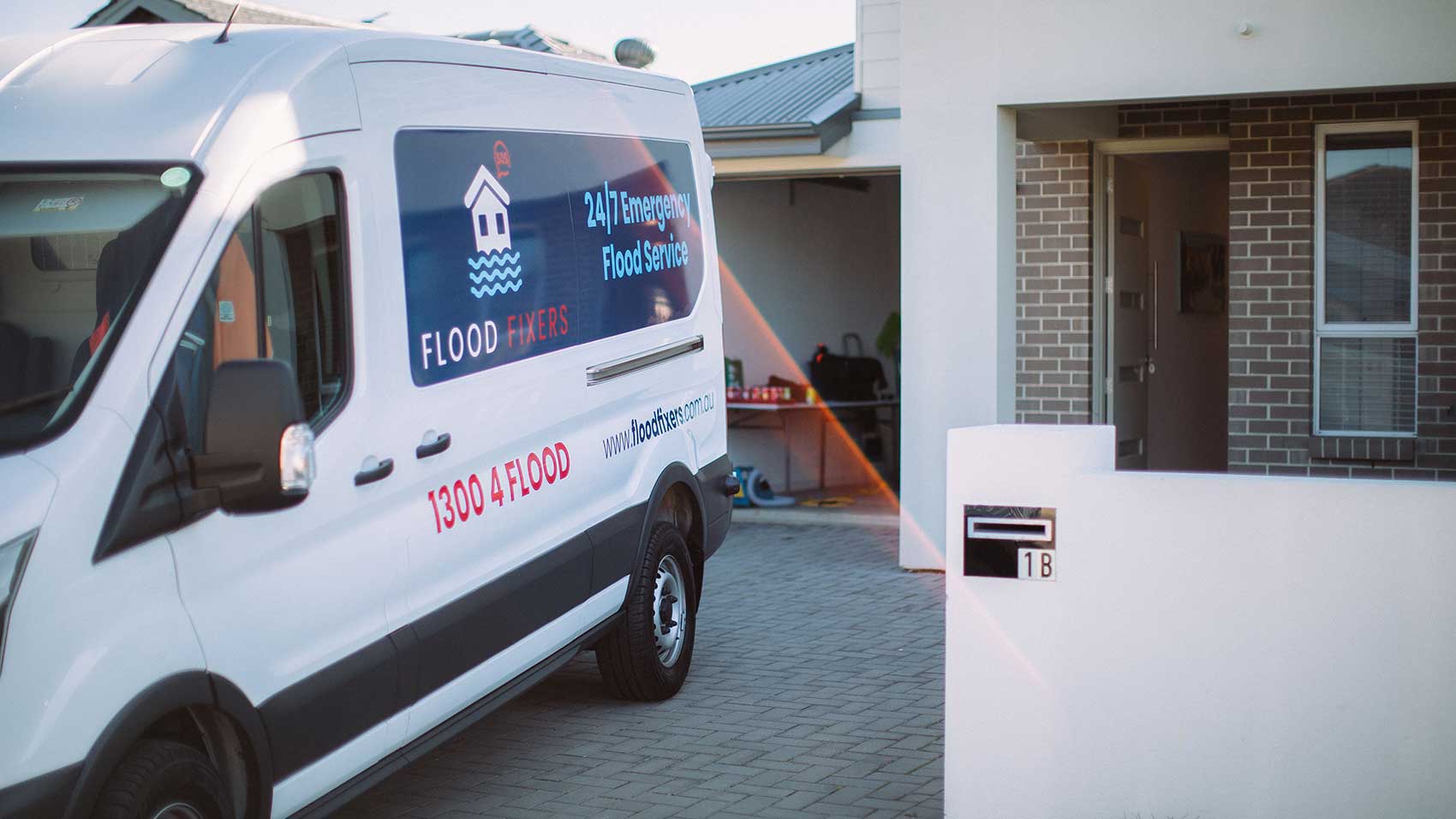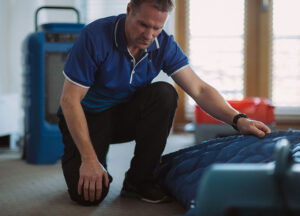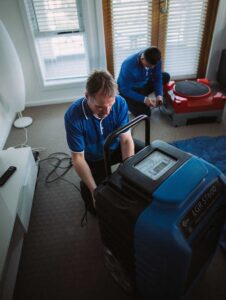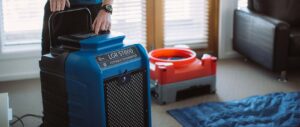How to dry a flooded room of wet carpet
Tips for Handling Flooding in a Single Room
If you’ve experienced flooding in just one room of your home or a single area of your commercial property, you might be considering tackling the cleanup yourself. While professional water damage restoration is always the safest option, there are a few important steps you can take to minimise damage before experts arrive.
The first and most important thing to remember is that time is critical. The longer water sits on your floors, especially on wet carpet and underlay, the deeper it will soak into the subfloor, walls, and surrounding materials.
This can quickly lead to mould growth, structural damage, and unpleasant odours that are far harder to remove later.
If you have wet carpet in the affected room, start by removing as much water as possible with towels or a wet vacuum if you have one. Move furniture and other items out of the room to prevent further damage, and try to increase ventilation by opening windows and doors if weather permits.
Setting up fans or heaters can also help speed up evaporation, but be careful to avoid electrical hazards if the room is still damp.
Even if you manage to remove most of the visible water, remember that moisture can remain trapped deep in carpets, underlay, and subfloors.
This is why professional water damage technicians use specialised drying equipment, dehumidifiers, and anti-microbial treatments to fully dry and sanitise the space, ensuring no hidden moisture remains to cause problems later on.
Safety comes first after flooding
When dealing with a flooded room, safety should always be your top priority. Water and electricity are a dangerous combination, so before you do anything, make sure the water level has not reached any power outlets. If it has, avoid the area until it has been inspected by a qualified electrician.
Any electrical appliances that have come into contact with water should be carefully removed from the room and checked by a professional before being used again. If you are unsure whether the flooded area is safe, it’s always best to have a licensed electrician inspect it first.
It’s also critical to understand the type of water involved in the flooding. If the room has been flooded by sewage water or storm water entering from outside, this is considered contaminated water. In these cases, do not attempt to clean or dry the area yourself.
Contaminated water carries serious health risks, and the flood cleanup should always be handled by an IICRC-accredited water damage restoration company with the right equipment, training, and safety protocols.
Remember:
-
Avoid flooded areas where electrical risks may be present
-
Have all affected electrical appliances tested before reuse
-
Do not try to clean or dry any room affected by sewage or contaminated floodwater
-
Contact professional water damage experts for contaminated water cleanup
Protecting furniture and personal belongings from water damage
Once it’s safe to enter the room, the next step is to protect your furniture and personal items from further damage. If possible, move everything out of the flooded area so the drying process can begin properly.
Heavy furniture that can’t be moved should be lifted or placed on protective materials such as aluminium foil or foam blocks to keep it off the wet flooring. Leaving furniture sitting in a damp environment will not only damage the furniture itself but also slow down the drying process for the room.
To minimise damage:
-
Remove as many items as possible from the affected room
-
Use foil or foam blocks to protect heavy furniture that can’t be moved
-
Keep the floor area clear so drying equipment can work efficiently
Ventilating the flooded room to release trapped moisture
If your property has experienced flooding, one of the first steps you can take is to ventilate the affected room as much as possible. Provided it’s not raining or overly humid outside, open all windows and doors to allow fresh, dry air to circulate through the space.
This simple step helps to push damp air out while replacing it with drier air from outside, significantly lowering humidity levels inside the flooded room.
For even better results, position an oscillating fan near a window or doorway so it directs the damp air out of the room. This additional airflow can dramatically reduce humidity levels and create the right conditions for drying.
To improve ventilation:
-
Open all windows and doors when weather conditions allow
-
Use an oscillating fan to push moist air out and draw in fresh, dry air
-
Encourage cross-ventilation throughout the property for better airflow
Removing floodwater safely and effectively
Once ventilation has been established, the next step is to remove as much standing water as possible. A wet vacuum designed specifically for water extraction is essential for this job.
Never use a standard household vacuum cleaner as it’s not built to handle liquids and poses a serious risk of electrocution or damage to the appliance.
If you don’t own a wet vac, most equipment hire stores rent them out for short-term use. For hard surfaces such as tiles, vinyl, or concrete, you may only need to make two or three passes with the wet vac to remove the water.
Wet carpets, however, are a different challenge. Because water seeps into both the carpet fibers and the underlay beneath, you will need to go over the affected area five to six times to extract as much moisture as possible.
Leaving a short pause between passes when extracting flood water allows the water to wick up from the underlay, helping you remove more moisture each time.
Key tips for water extraction:
-
Use a proper wet vac designed for floodwater removal
-
Avoid household vacuum cleaners for safety reasons
-
Repeat the process multiple times for waterlogged carpets
-
Allow short waiting periods between passes to improve extraction results
Drying out a water-damaged room properly
If you’ve had a room flooded in your home or business, removing the standing water is only the first step. The real challenge lies in drying the space thoroughly to prevent hidden moisture from causing structural damage or mould growth later on.
Effective water damage drying requires the right equipment, the correct setup, and enough time to ensure every part of the affected area is completely dry.
For homeowners looking to handle minor water damage themselves, hiring professional-grade drying equipment is the way to go. Most local equipment hire companies or water damage restoration specialists offer affordable weekly rates on commercial drying equipment, and this is a cost-effective solution compared to the expenses of full-scale flood remediation if the job isn’t done properly.
Recommended equipment for drying a standard-sized flooded room
For an average-sized room of around 14 to 20 square metres, you will typically need:
-
Three high-velocity air movers to circulate air and speed up evaporation
-
One low-grain refrigerant (LGR) dehumidifier to remove moisture from the air and materials
Position the air movers around the perimeter of the room at 45-degree angles, directing the airflow towards the walls. This setup creates a continuous circular airflow, ensuring that moisture is lifted from all surfaces and pulled into the air for the dehumidifier to capture.
Place the LGR dehumidifier in the centre of the room to draw out humidity as the air movers circulate it.
Maximising airflow and controlling humidity
During the first couple of days, if the weather outside is warm and dry, keep windows and doors open to allow fresh air to assist with the drying process.
As the room begins to dry and indoor air becomes drier than the outside air, close the windows and doors so the dehumidifier can continue lowering humidity levels inside the room efficiently.
Be patient, this process takes time. It usually takes at least 7 days to completely dry a flooded room because you’re not just drying the carpet or flooring. Moisture often seeps into the walls, subfloors, and building framework, so drying must be thorough to prevent future issues.
Common mistakes to avoid when drying a flooded room
One of the biggest DIY drying mistakes is stopping too early because the room “feels” dry. Even if surfaces seem dry to the touch, moisture can remain trapped deep inside walls, underlay, and structural materials.
For this reason, keep the drying equipment running for the full recommended period—usually 7 days or longer for more severe flooding.
Wet carpet drying after flooding On The Gold Coast
When flooding affects a carpeted room, removing the water is only part of the job. Once the carpet is no longer saturated, it’s important to give it a thorough clean to remove any lingering odours, dirt, and bacteria that may have been left behind by the floodwater.
For smaller areas or DIY projects, you can hire a carpet cleaning machine from your local equipment hire store. These machines are user-friendly and ideal for deep cleaning carpets after flooding. Since you’ll have the machine on hand, it’s a great opportunity to freshen up other carpets throughout your home as well.
For a professional finish, many homeowners prefer to call in local carpet cleaning specialists. Steam cleaning or hot water extraction treatments not only leave your carpets smelling fresh but also help remove stains, allergens, and bacteria that may otherwise remain trapped in the fibres.
Professional flooded house drying services on the Gold Coast
If you’ve tried drying your flooded room yourself and it feels like the job is too big, Flood Fixers is here to help. We are a professional water damage restoration company on The Gold Coast with many years of experience providing expert flooded house drying services across the entire Gold Coast Region and beyond.
Our team understands how stressful water damage can be, and we are available 24/7 to offer obligation-free advice to anyone dealing with flooding. Whether it’s one room or an entire property, we have accredited water damage restoration technicians ready to step in with professional-grade equipment to handle even the toughest jobs.
We specialise in:
-
Flooded house drying
-
Flooded building drying
-
Flooded apartment drying
- Structural water damage drying
- Mould remediation & mould prevention
Our goal is to restore your property quickly and efficiently while minimising long-term damage, so you can get back to normal as soon as possible. If you need some help with drying your flooded room of wet carpet, we are here to help 24/7!
If you need water damage service or advice on how to dry wet carpet on the Gold Coast, please call the Flood Fixers Team anytime




